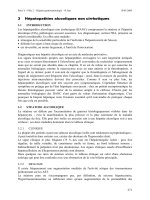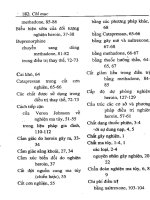Understanding Cosmetic Laser Surgery - part 10 pot
Bạn đang xem bản rút gọn của tài liệu. Xem và tải ngay bản đầy đủ của tài liệu tại đây (99.12 KB, 9 trang )
Glossary / 87
varying levels of differentiation, and provides a physical barrier
with the environment outside the body. Also includes melanocytes
(pigment-producing cells).
Fascia A tough connective tissue layer (composed mainly of colla-
gen) that covers many muscles in the body and provides a physi-
cal connection between muscles and more superficial structures.
The superficial fascia of the face (SMAS) is attached to the skin
via connective tissue. When the facial muscles contract, the fascia
conveys facial expression to the skin.
Fibroblast The major cell type in the dermis. Fibroblasts produce
the protein molecules that assemble into collagen and elastic
fibers. These fibers provide both strength and elasticity to the
skin.
Flashlamp An intensely bright electric lamp that flashes on for a
very brief period. Used in certain types of lasers as an energy
source to stimulate the excitable molecules within the laser
chamber.
Granular cell layer Epidermal layer just above the prickle cell layer.
Keratinocytes of this layer are more highly differentiated than in
lower layers and exhibit dark color granules when viewed with a
microscope.
Hemangioma A type of benign tumor, composed of blood vessels
(mainly capillaries), that arises in the dermis. A hemangioma will
appear as a red lesion and is usually elevated above the surround-
ing skin. Many hemangiomas appear in early childhood and if not
treated will grow for several months, then shrink and largely dis-
appear, leaving an area of scar tissue in the skin.
Hemoglobin The red, iron-containing protein within red blood
cells that binds oxygen molecules for transport from the lungs to
the tissues of the body.
Hemosiderin A brown or orange pigment that appears in the skin
after red blood cells have leaked out of blood vessels into the der-
mis. Hemosiderin results from the breakdown of hemoglobin and
has a large iron component.
Incisional surgery A type of surgery in which tissue is cut out
(incised) as with a scalpel blade or a focused CO
2
laser.
Infrared Electromagnetic energy with wavelengths longer than
700 nanometers. Beyond the visible light spectrum, with energy
levels lower than those of red light (infra ϭ below).
Keratinocyte The predominant cell type of the epidermis. These
cells produce a protein called keratin.
Laser An acronym for Light Amplification by the Stimulated
Emission of Radiation. This term is used to describe the physical
process by which laser energy is produced as well as the machine
(a laser) that produces laser energy.
Laser resurfacing A surgical procedure in which an ablative (see
ablation) laser is used to remove superficial layers of skin.
Lentigo See solar lentigo.
Liposuction Surgical procedure in which subcutaneous fat is
removed via suction. Usually done with tumescent anesthesia
(tumescent liposuction).
Macrophage A relatively large white blood cell that migrates from
capillaries to other tissues, including the dermis. These cells ingest
debris (including tattoo ink particles) and remove it from the skin
by migrating into lymphatic vessels and transporting the debris
to nearby lymph nodes or to the liver.
Melanin Proteinaceous pigment in skin that screens out ultraviolet
light.
Melanocyte Melanin-producing cell in the epidermis.
Melanosome The organelle (membrane-bound structure) within
the melanocyte that synthesizes melanin. Melanin gets into kera-
tinocytes by the transfer of melanosomes.
Microdermabrasion A mild facial treatment in which tiny parti-
cles (usually aluminum oxide) are blown against the skin at high
velocity, gently “sandblasting” superficial epidermal layers.
Monochromicity The property of being composed of a single
wavelength of electromagnetic radiation (for example, a single
color of light in the visible spectrum) (mono ϭ one, chroma ϭ
color). A feature of laser energy.
Nanometer One billionth of a meter. Abbreviated as nm.
Nanosecond One billionth of a second . Abbreviated as nsec.
Nevus (pl. nevi) A skin lesion composed of cells that are normally
88 / Glossary
present in the skin but that are increased in number. There are
several types of nevi; they are denoted by the type of skin cell
involved. A melanocytic nevus is composed of increased numbers
of melanocytes. An epidermal nevus is composed of increased
numbers of keratinocytes.
Orbicularis oris A circular muscle that surrounds the mouth.
When this muscle contracts, the lips pucker.
Photon The fundamental unit of electromagnetic energy. The pho-
ton has properties of both a particle and a wave.
Platysma A broad, thin muscle that attaches to the clavicle (collar-
bone) and runs up the side of the neck and onto the cheeks,
where it is continuous with the SMAS fascia.
Port wine stain A common birthmark composed of a flat red
patch of skin. In a port wine stain, the capillaries in the dermis are
chronically dilated. If untreated, with age a port wine stain may
become darker and develop raised components.
Prickle cell layer Epidermal layer just above the basal layer. In the
prickle cell layer the keratinocytes are larger than in the basal layer
and exhibit spiny attachments to each other.
Q-switched laser A laser with an extremely short pulse (5–40
nanoseconds). Used for nonsurgical removal of tattoo ink or skin
pigment.
Quantum theory The theory that radiant energy is composed of
finite quanta; explains the structure of atoms and molecules and
how energy and matter interact.
Selective photothermolysis The underlying principle of cosmetic
laser treatments. Light (photo) of a specific wavelength is selec-
tively absorbed by a targeted chromophore in the skin, generating
enough heat (thermo) to destroy (lyse) the tissue. The effect of
the laser is selective because the unwanted skin component (the
chromophore) readily absorbs laser energy of the chosen wave-
length. Skin components other than the chromophore are not
affected.
SMAS Superficial musculo-aponeurotic system: the superficial
muscles of the face along with the fascia that connects them. The
SMAS includes the platysma muscle on the lower cheek and
Glossary / 89
neck. In a facelift operation, the SMAS is pulled upwards and
backwards (usually with sutures) to reverse the sagging that
occurs with aging.
Solar elastosis Changes in the skin caused by chronic sun expo-
sure. A sign of photo-aging that includes increased amounts of
abnormal elastic fibers in the dermis.
Solar keratosis A skin lesion caused by chronic exposure to sun-
light. Also referred to as actinic keratoses (plural), these lesions
appear as rough red patches in the most sun-exposed areas of the
body, especially the face. Most solar keratoses are one-quarter inch
or less in diameter. If not treated they may progress to become a
squamous cell carcinoma (skin cancer).
Solar lentigo A flat, brown spot that appears in areas of the skin
chronically exposed to sunlight. Similar to a freckle, these age
spots are patches of skin that contain increased amounts of
melanin, the skin pigment.
Stratum corneum Topmost (outer) epidermal layer. Composed of
terminally differentiated keratinocytes that have died and become
large and flat. The stratum corneum functions as a protective bar-
rier with the outside environment and also prevents water loss
from lower skin layers. The dead cells of the stratum corneum
flake off as they are replaced by new cells from below.
Subcision A minor surgical procedure in which the sharp edge of a
hypodermic needle is used to cut through connective tissue and
scar tissue. Used to help elevate depressed scars.
Subcutaneous Beneath the skin.
Telangiectasia A visibly dilated blood vessel, generally less than
1mm in diameter. May appear on the face as a result of chronic
sun damage or in association with rosacea (an acne-like skin
disease).
Tumescent anesthesia A method of local anesthesia used for sur-
gery in which a relatively dilute local anesthetic drug, usually
lidocaine (dissolved in a salt-water solution) is injected into tis-
sue. A relatively large volume of the anesthetic solution is injected
to ensure that the tissue is completely anesthetized. The tumes-
cent anesthetic solution usually includes a low concentration of
90 / Glossary
epinephrine, a drug that causes blood vessels to constrict (greatly
reducing bleeding during surgery).
Ultraviolet Electromagnetic energy situated beyond the violet end
of the visible spectrum (ultra ϭ beyond); wavelengths are shorter
than 400 nanometers.
Glossary / 91
This page intentionally left blank
absorption spectrum, 31, 37, 39
acne scars. See scars, acne
aging: of face and neck, 26–28; of
skin, 15–18
alexandrite laser, 40, 41, 46, 48, 50;
wavelength of, 48
American Academy of Facial Plastic
Surgery, 83
American Society for Dermatologic
Surgery, 83
American Society for Lasers in
Medicine and Surgery, 83
American Society of Plastic
Surgeons, 83
Anderson, Rox, 32, 34, 48
anesthesia, 43, 44, 45, 46, 47, 49,
53, 54, 60, 61, 62, 66, 71, 72, 73,
74, 76, 77; for CO
2
laser
resurfacing, 60–62; for
erbium:YAG laser resurfacing,
53–54; tumescent, 71–73
argon laser, 39, 40, 46
basal layer of epidermis, 10, 11, 13,
32
birthmarks, 21–23
blepharoplasty, 66–69; lower eyelid,
68–69; transconjunctival, 68–69;
upper eyelid, 66–68
blood vessels, 11, 12, 18, 19, 21–22,
24, 29, 30, 32, 34, 36, 38, 39, 40,
43, 44, 45, 46, 52, 54, 57, 62, 65,
66, 68, 71, 73, 80, 84; “broken,”
18; contribution to skin color, 12;
in birthmarks, 21–22; in scars,
24. See also vascular skin lesions
Bohr, Niels, 3
Botox. See botulinum toxin
botulinum toxin, 74–76; and laser
resurfacing, 76; mechanism of
action, 75
cafe au lait spots, 23; laser
treatment of, 46
Candela Corporation, 38, 39
capillaries, 12, 19, 21, 22, 38, 39,
43, 44, 45, 57
chromophore, 29, 30–32, 34, 35, 37,
40, 41, 49, 51; definition of, 30; as
target of laser, 30; water as, 35, 37
Coblation, 80–81; vs. erbium:YAG
laser, 81
coherence, 6, 8
collagen, 13, 23, 24, 26, 55, 62, 76,
77, 78, 79, 80
collimation, 8
copper bromide laser, 40
copper vapor laser, 40
CO
2
laser, 35, 36, 37, 38, 48, 53,
54, 55, 57, 58, 59–65, 66–69, 70,
74, 76; for blepharoplasty, 66–69;
bloodless surgery and, 36; vs.
erbium:YAG laser, 52–56, 58
dermis, 10, 11, 12–15, 17–18,
19–21, 22, 23, 25, 30, 35, 38, 40,
41, 44, 47, 49, 50, 54, 62, 63, 78,
79, 80; aging of, 17–18; discolor-
ation of, 19–21; structure of,
12–15; thickness of, 25
diode laser, 32, 40, 46, 50, 79
double chin, 26, 71; liposuction
for, 71
Index
Einstein, Albert, viii, 5
elastin, 14, 15
elastosis, solar. See solar elastosis
electromagnetic spectrum, 4, 5, 30,
33, 35, 37
electron, xiii, 5
epidermis, 10, 11, 12, 13, 16, 18,
19, 20, 21, 22, 25, 29, 32, 35, 41,
45, 49, 50, 51, 52, 57, 58, 62, 64,
65, 77, 78, 79, 80; differentiation
of, 10–11
erbium:YAG laser, 37, 38, 47, 52,
53–58, 60, 63, 76, 79, 80, 81;
laser resurfacing with, 53–58; vs.
CO
2
laser, 52–56, 58
face and neck: aging of (see aging, of
face and neck); anatomy of, 25–26
facelift, 27, 28, 59, 71, 72, 73, 74
fat, 10, 13, 25, 26, 27, 28, 59, 62,
66, 68, 71; augmentation of, 28
fibroblast, 13, 78
forehead lift, 27
freckles, laser treatment of, 46
Goldman, Leon, 34, 35, 42
hair follicles, ix, x, 12, 13, 41, 43, 50
hair removal lasers: development of,
41–42; treatment with, 50–51.
See also laser hair removal
hemangioma, 19, 21, 22, 44, 45;
laser treatment of, 44–45
hemoglobin, xi, 12, 19, 20, 21, 30,
31, 32, 34, 39, 40, 44, 79;
absorption spectrum of, 31
hemosiderin, 19, 20
infrared, 4, 5, 35, 37, 40, 79
Intense Pulsed Light (IPL), 78–79
International Society of Cosmetic
Laser Surgeons, 83
jowls, 18, 25, 26, 27, 71, 72, 73, 74
keratinocyte, 10, 11, 12, 13, 16, 21
keratoses, solar. See solar keratoses
krypton laser, 30, 40, 44, 46, 47
laser: apparatus, 6; power of, 29;
properties, 8; pulse width of, 29;
wavelength of, 29
laser blepharoplasty. See
blepharoplasty
laser hair removal: electrolysis,
comparison with, 51; treatment,
50–51
laser resurfacing, x, xi, 13, 27, 28,
29, 37, 38, 43, 52, 53, 54, 56, 57,
58, 59, 60, 61, 62, 63, 64, 65, 68,
70, 71, 72, 74, 76, 77, 78, 80, 84;
and Botox, 76; with CO
2
laser,
59–65; with erbium:YAG laser,
53–58; healing after, 13
laser surgeon, qualifications of, 82–83
laser surgery: consultation for,
83–84; incisional, 43, 65;
resurfacing (see also laser
resurfacing). See also
blepharoplasty
lentigo, laser treatment of, 46
lentigo, solar. See solar lentigo
liposuction, 62, 71, 72, 73, 74
macrophage, 19, 20, 21, 41, 44,
45, 49
melanin, xi, 12, 13, 16, 19, 20, 21,
22, 23, 30–32, 41, 46, 50, 51, 58,
79; absorption spectrum of, 31; as
chromophore, 30
melanocyte, 11, 12, 13, 16, 19, 22,
23, 24, 30, 58
melanocytic nevi, 22–23; laser
treatment of, 46–47
microdermabrasion, 79–80
moles. See melanocytic nevi
monochromacity, 8
94 / Index
Nd:YAG laser, 32, 37, 38, 40, 41,
46, 47, 48, 50, 52, 53, 54, 55, 56,
57, 58, 60, 63, 76, 78, 80, 81;
wavelength of, 48. See also
Q-switched lasers
nevus, 19, 22, 23, 46, 47; congenital,
22–23; melanocytic, 22–23; of
Ota, 22
non-ablative laser resurfacing,
77–79; CoolTouch laser for, 78;
IPL for, 78–79; pulsed dye laser
for, 78–79; Q-switched Nd:YAG
laser for, 78
Parrish, John, 32, 34
photon, xiii, 5, 6
pigment cell. See melanocyte
pigmented skin lesions, laser
treatment of, 46–47
Planck, Max, xiii
platysma muscle, 26, 27, 71, 72, 73
platysmaplasty, 27, 72, 73
port wine stains, 21, 22, 29, 38, 39,
40, 43–44; laser treatment of,
43–44
post inflammatory hyperpigmenta-
tion, 20
post-traumatic scars. See scars,
post-traumatic
pulsed dye laser, 30, 38, 39–40, 43,
44, 45, 46, 78; development of,
39–40; treatment with, 43–44
purpura, 44, 45, 46, 78
Q-switch, 35, 40, 41
Q-switched lasers, 34, 40, 41, 46,
47, 48, 49, 78; for treating benign
pigmented lesions, 41; for treating
tattoos, 40–41
quantum theory, viii, 3
rosacea, 18, 39, 45
ruby laser, 34, 40, 42, 47;
wavelength of, 48
scars, 23–24; acne, 24, 76–77;
erbium:YAG laser resurfacing of,
55–56; post-traumatic, 24
scattering, 32
selective photothermolysis, 29, 34,
35, 37, 38, 39, 40, 48
Skin: aging of, 15–18; and smoking,
18–19; structure of, 10–15
solar elastosis, 17, 18, 19
solar keratoses, 16, 27, 37
solar lentigo, 16
spontaneous emission, 3, 6
stimulated emission, viii, 5, 6
stratum corneum, 11, 13, 16, 35, 79
subcision, 24, 76, 77
sun damage, 15–18
superficial musculoaponeurotic
system (SMAS), 26
sweat glands, 12, 13
tattoos, viii, x, 20, 21, 30, 31, 34,
35, 40–41, 48–50; carbon-based,
21; laser treatment of, 48–50;
Q-switched lasers for treating,
40–41
telangiectases, laser treatment of,
45–46
thermal relaxation time, 32–34
tumescent anesthesia. See anesthesia,
tumescent
ultraviolet, 4, 5, 12, 58
vascular skin lesions, treatment of,
43–46. See also blood vessels
Index / 95









